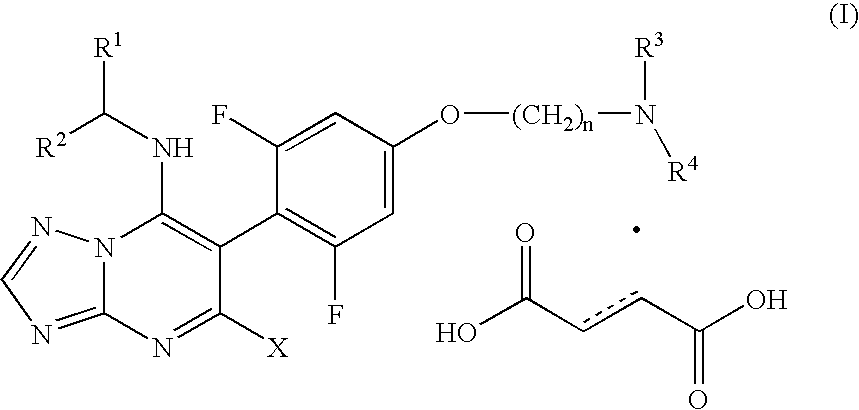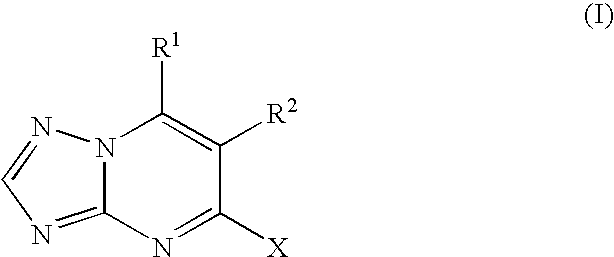Process for the preparation of tubulin inhibitors
a tubulin inhibitor and process technology, applied in the field of triazolopyrimidine dicarboxylic acid salts, can solve the problems of inability to achieve laboratory-based process, inability to prepare large-scale preparations, and inability to apoptose cells
- Summary
- Abstract
- Description
- Claims
- Application Information
AI Technical Summary
Benefits of technology
Problems solved by technology
Method used
Image
Examples
example 1
Disodium Salt of 6-(2,4,6-trifluorophenyl)-[1,2,4]triazolo[1,5-a]pyrimidine-5.7-diol
[0073] A mixture of 2-(2,4,6-trifluoro-phenyl)-malonic acid diethyl ester (400 g, 1.38 mol), 3-amino-1,2,4-triazole (122 g, 1.45 mol) and tributylamine (255 g, 1.38 mol) is heated to about 150° C. and stirred for about 2 h. The mixture is cooled to about 130° C. and the heating source is removed. Toluene (1600 mL) is then added over 30 min. The mixture is cooled to room temperature and sodium hydroxide solution (50%, 220 g, 2.76 mol) is added over about 15 min. The mixture is stirred for about 1 h from about 20° C. to about 30° C. The solid is filtered and washed with toluene (2×600 mL) and dried at 80° C. / 10 mmHg for 40 h to give a white solid (470 g, 105%, >95% HPLC area purity), which is used directly in the next step.
example 2
5,7-dichloro-6-(2,4,6-trifluorophenyl)-[1,2,4]triazolo[1,5-a]-pyrimidine
[0074] To phosphorus oxychloride (1900 mL) is added disodium salt of 6-(2,4,6-trifluorophenyl)-[1,2,4]triazolo[1,5-a]pyrimidine-5.7-diol (470 g, 1.38 mol) in portions over about 30 min. The mixture is heated to reflux for about 16 h. The solvent is removed by distillation to a residue and the residue distilled with toluene (2×500 mL). Then, the residue is dissolved into ethyl acetate (1000 mL) and the resulted mixture is poured into water (3000 g) while maintaining the temperature between 5-15° C. The organic phase is separated. The combined organic phase is washed with water (1000 mL) and dried over Na2SO4. After most of the solvent is removed by distillation, IPA (2×500 mL) is added and distillation continued to a residue. The residue is dissolved in IPA (2350 mL) and heated to about 60° C. The mixture is filtered at 50-60° C. and the filtrate is cooled to about 0° C. over about 1 h and stirred for about anot...
example 3
[5-Chloro-6-(2,4,6-trifluoro-phenyl)-[1,2,4]triazolo[1,5-a]pyrimidin-7-yl]-((1S)-2,2,2-trifluoro-1-methyl-ethyl)-amine
[0075] To a solution of 5,7-dichloro-6-(2,4,6-trifluorophenyl)-[1,2,4]triazolo[1,5-a]-pyrimidine (200 g, 0.627 mol) in anhydrous DMF (1000 mL) is added (S)-2,2,2-trifluoro-1-methyl-ethylamine (177 g, 1.57 mol). The solution is stirred from about 20° C. to about 30° C. for 24 h. The reaction mixture is added to cold water (3000 mL) slowly over 30 min. The mixture is stirred for 30 min at 10-20° C. The solid product is filtered and washed with water (2×500 mL). The crude product is dissolved into IPA (1000 mL) at 50° C. Water (2000 mL) is added to precipitate the product over 30 min. The mixture is cooled to 0° C. over 1 h and stirred for 1 h at this temperature. The solid is filtered and dried at 65° C. / 10 mmHg for 20 h to give a light yellow solid (204 g, 82%, 98% HPLC area purity and 99% ee).
PUM
| Property | Measurement | Unit |
|---|---|---|
| temperature | aaaaa | aaaaa |
| temperature | aaaaa | aaaaa |
| temperature | aaaaa | aaaaa |
Abstract
Description
Claims
Application Information
 Login to View More
Login to View More - R&D
- Intellectual Property
- Life Sciences
- Materials
- Tech Scout
- Unparalleled Data Quality
- Higher Quality Content
- 60% Fewer Hallucinations
Browse by: Latest US Patents, China's latest patents, Technical Efficacy Thesaurus, Application Domain, Technology Topic, Popular Technical Reports.
© 2025 PatSnap. All rights reserved.Legal|Privacy policy|Modern Slavery Act Transparency Statement|Sitemap|About US| Contact US: help@patsnap.com



